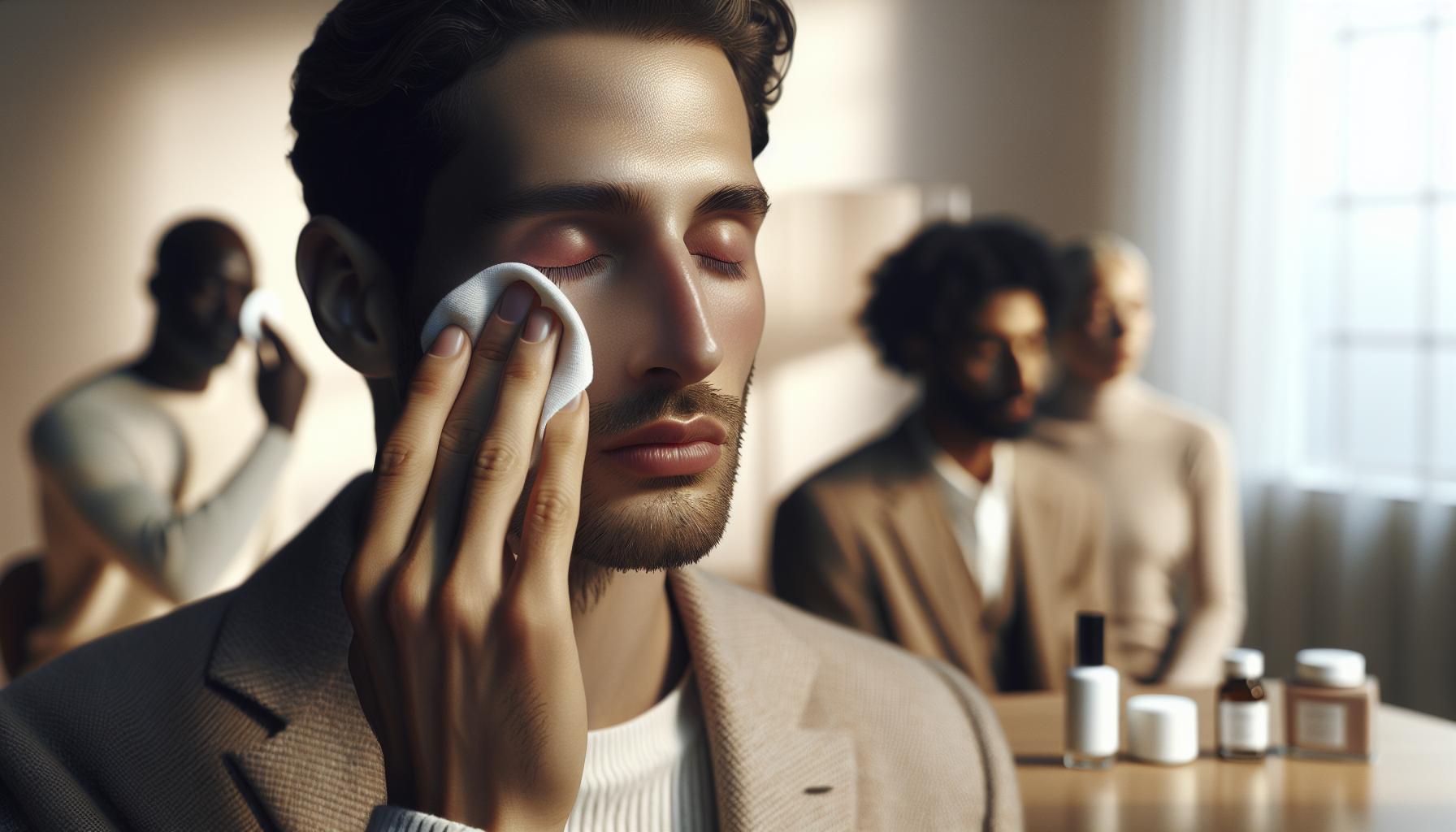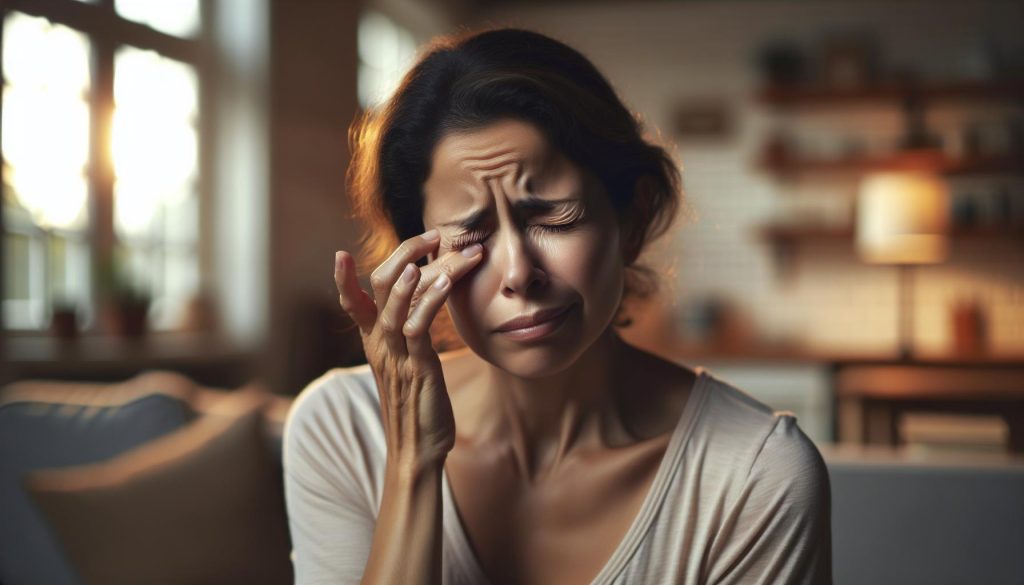Did you know that a common eye irritation, like a stye, can lead to an unexpected symptom: eye twitching? As frustrating as this may be, it’s important to understand the connection between these two issues. A stye, caused by a bacterial infection of the glands around the eyelashes, can trigger stress and discomfort that might affect the nerves around your eyes, leading to involuntary muscle contractions or twitching.
If you’ve ever dealt with the annoyance of a stye, you know how it can make you feel self-conscious. The good news is that while styes can be painful, they’re usually harmless and often resolve on their own. However, combining the discomfort of a stye with the irritation of eye twitching can feel overwhelming. In this article, we’ll explore the links between styes and eye twitching, helping you understand the nerve-wracking truth behind these conditions and offering tips for relief. Continue reading to empower yourself with knowledge and strategies to care for your eyes effectively.
Can Styes Cause Eye Twitching? Understanding the Connection

While you might not typically associate a stye with eye twitching, there is indeed a connection worth exploring. A stye, a localized infection of an oil gland in the eyelid, can create discomfort, inflammation, and increased sensitivity around the eye area. This irritation may lead to involuntary muscle contractions, or twitching, as a response to the discomfort or as a side effect of the body’s stress response.
When experiencing a stye, the surrounding muscles may become tense or overworked due to factors such as pain or constant rubbing of the eye. This unnecessary strain can trigger eye twitching, particularly if you find yourself subconsciously squinting or trying to alleviate the sensation of your stye. Moreover, styes can contribute to eye fatigue, especially if they affect your ability to see clearly, which may further exacerbate twitching sensations.
Additionally, external factors such as stress and lack of sleep can compound the problem. If you’re already feeling stressed or overtired, the irritation from a stye could be the final straw that triggers muscle spasms in your eyelid. Using strategies to relieve stress, resting properly, and taking care of your stye with appropriate home remedies can provide both symptom relief and a calming effect on your body.
Understanding the interconnectedness of these symptoms can empower you to recognize signs of your body’s stress signals more effectively. Should the twitching persist even after your stye resolves, it may be wise to consult a healthcare professional to rule out other potential causes and find a tailored approach to managing your symptoms.
What Is a Stye? Symptoms and Causes Explained

A stye is a common and often uncomfortable condition that arises from a bacterial infection of the oil glands in your eyelid. These infections typically manifest as a painful, red bump near the edge of the eyelid, resembling a pimple, and can be caused by factors such as inadequate hygiene, rubbing your eyes, or using contaminated cosmetics. While styes are generally not serious, they can result in irritation that affects both comfort and appearance, prompting many to seek remedies for symptom relief.
The symptoms usually include localized swelling, tenderness, and sometimes a throbbing sensation. You may also notice watery eyes or a gritty feeling, which can be bothersome. In some cases, the presence of a stye can lead to eyelid twitching. This Twitching may develop due to the tension and discomfort around the affected area, leading to involuntary muscle contractions as your eyelids strain to cope with the irritation. It’s essential to recognize that while a stye itself isn’t a direct cause of twitching, the tension it creates and the body’s stress response may trigger this issue.
To alleviate the discomfort associated with a stye, consider implementing warm compresses to the affected area, which can help alleviate discomfort and promote healing. Over-the-counter pain relievers may also be helpful in managing pain and reducing inflammation. Additionally, maintaining proper hygiene by cleaning your eyelid gently with mild soap and water can prevent the recurrence of styes. If you notice persistent symptoms or the stye does not improve within a week, it’s advisable to consult a healthcare professional who can provide targeted treatment options.
Remember, taking steps to manage stress and fatigue-two common triggers for both styes and eye twitching-can also be beneficial. By adopting a holistic approach to eye health that includes self-care and good hygiene, you can navigate the challenges presented by styes and their associated symptoms more effectively.
The Science Behind Eye Twitching

Involuntary eyelid twitching, medically known as myokymia, can often leave you feeling puzzled and frustrated. This phenomenon occurs when the delicate muscles in the eyelid begin to spasm intermittently. While it might be tempting to dismiss these twitches as mere nuisances, understanding the underlying mechanisms can provide valuable insights into their causes and management.
Eyelid twitching is frequently triggered by various factors, with stress and fatigue topping the list. When the body is under stress, it releases certain hormones that can affect muscle function and nerve activity, leading to involuntary contractions. In addition, fatigue results in diminished neurological functioning and muscle control, which can exacerbate twitching episodes. Interestingly, individuals experiencing discomfort from conditions like styes may find themselves more vulnerable to these twitches, as the tension and irritation in the eye area may amplify stress responses, resulting in increased muscle spasms.
The body’s complex nervous system also plays a significant role in eye twitching. The eyelid is innervated by the facial nerve, which controls its movements. Any disturbance in this nerve’s functioning-whether from environmental stressors, fatigue, or irritation from a stye-can lead to twitching. Furthermore, excessive caffeine intake can overstimulate muscle activity and contribute to increased twitching episodes, highlighting the important relationship between lifestyle choices and nerve health.
To cope with eyelid twitching effectively, adopting stress-reduction techniques like mindfulness, yoga, or simple breathing exercises can be beneficial. Additionally, ensuring adequate rest and reducing caffeine intake might alleviate symptoms significantly. If twitching persists despite these interventions, or if it worsens, it’s advisable to consult a healthcare professional to rule out any underlying conditions. Embracing a holistic approach to eye health can empower you to tackle both the discomfort of styes and the irritation of twitching, allowing for a more comfortable and confident daily life.
How Do Styes Affect Our Vision?
A stye can significantly impact how you see the world, both literally and figuratively. When a stye forms-usually as a painful bump on the eyelid-it may cause discomfort that distracts from your daily activities. Although styes are generally harmless and often resolve on their own, understanding their influence on vision and eye comfort is essential.
Individuals with a stye might experience symptoms like swelling, redness, and irritation in the affected area. These symptoms can lead to a temporary blurring or distortion of vision, making it difficult to focus. The pain and pressure from the stye can lead to squinting or abnormal eye movements, which can further affect visual clarity. Additionally, the presence of a stye may lead you to rub or touch your eyes more frequently, potentially introducing more irritants and causing further issues like swelling or secondary infections.
Moreover, if left untreated or if they become infected, styes can contribute to more serious complications, such as chalazia-a blockage of the oil glands in the eyelids which can become increasingly painful and may require medical intervention. Thus, maintaining eye hygiene and ensuring that styes are properly addressed is crucial for preserving overall eye health and comfort.
If you notice a stye, consider the following steps to protect your vision:
- Apply warm compresses to the affected eyelid several times a day to reduce swelling and discomfort.
- Maintain good eyelid hygiene, gently cleaning the area with diluted baby shampoo or eyelid scrub pads.
- Avoid wearing eye makeup or contact lenses until the stye has healed to prevent further irritation.
As you navigate this discomfort, remember that your eye health is paramount, and timely care can help you return to your daily activities with clear and comfortable vision.
Nerve Disturbances: Why They Happen
Nerve disturbances can be perplexing, particularly when you experience symptoms such as eye twitching alongside other conditions like styes. The connection lies in the intricate network of signals in the nervous system that regulate muscle movement around your eyes. A stye causes localized inflammation and discomfort, which may trigger a heightened response from the nearby nerves. This irritation can result in involuntary muscle contractions, commonly recognized as eye twitching or spasms.
When the eye area is inflamed or irritated, as is often the case with a stye, the nervous system may overreact. The body perceives the discomfort as a stress signal, and in response, it may lead to spasms in the eyelid muscles. It’s akin to how stress can manifest physically-while the irritation from a stye may not seem severe, the body may respond dramatically. In many cases, the twitching is harmless and temporary, easing up once the stye resolves.
Understanding this connection underscores the importance of managing stress and discomfort to avoid exacerbating nerve-related symptoms. Solutions to mitigate this issue often lie in self-care practices. Applying warm compresses to the affected area can not only soothe the stye but also help reduce muscle tension around the eyes. Additionally, ensuring that your eyes are well-hydrated through proper nutrition and hydration can strengthen your overall eye health, potentially reducing the likelihood of twitching.
Incorporating stress-relief techniques such as mindfulness or relaxation exercises can further contribute to easing eye twitching. Focusing on these holistic approaches helps to promote both physical and mental well-being, ultimately enhancing your experience with eye health and comfort. By addressing the root cause of nerve disturbances, such as inflammation from a stye and overall stress levels, you empower yourself to maintain clarity and calm in your daily life.
At-Home Remedies for Stye Relief
Applying the right at-home remedies can significantly alleviate the discomfort of a stye while also addressing potential eye twitching associated with it. Styes, which typically manifest as small, painful lumps on the eyelids, are often caused by blocked glands or bacterial infections. Fortunately, you can implement several simple and effective strategies in the comfort of your home to promote healing and relieve symptoms.
One of the most beneficial approaches is to use warm compresses. Soak a clean cloth in warm water, wring it out to remove excess moisture, and then gently place it over the affected eye for about 10 to 15 minutes. This warmth helps to reduce inflammation, soften any crust, and encourage drainage of the stye. Repeat this process three to four times a day for optimal results. Be mindful to use a separate cloth for each eye if both are affected to avoid further irritation.
Incorporating gentle eyelid hygiene can also be a game changer. Use a diluted baby shampoo or a specially formulated eyelid scrub to cleanse your eyelids daily. This practice eliminates excess oil and bacteria that can contribute to styes and helps keep your eyelid margins clean. Simply mix a few drops of shampoo in warm water, dip a clean cotton pad into the solution, and carefully wipe your eyelids from the inside out.
Hydration should not be overlooked either. Drinking plenty of fluids throughout the day supports your overall eye health and can help prevent dry eyes, which may exacerbate twitching. Opt for water and herbal teas, while ensuring a balanced diet rich in vitamins and minerals that promote eye health, such as leafy greens and omega-3 fatty acids found in fish.
Natural Ingredients for Soothing Relief
Further enhancing your routine can be achieved with natural ingredients. Consider the following options:
- Green Tea Bags: After steeping and cooling used green tea bags, place them on your closed eyelids. The antioxidants and anti-inflammatory properties can aid in reducing swelling.
- Aloe Vera Gel: Applying a thin layer of pure aloe vera gel to the affected area can soothe discomfort due to its anti-inflammatory effects.
- Coconut Oil: This can be used as a gentle moisturizer for eyelids, creating a barrier that may help prevent further irritation.
While home remedies are effective for many, it’s crucial to recognize when professional medical help is required. If a stye does not improve within a few days or worsens, seeking guidance from a healthcare provider is essential. 用
When to Seek Professional Help for Styes
Experiencing a stye can be uncomfortable and frustrating, particularly when it coincides with eye twitching-an involuntary muscle spasm that can add to your distress. While many styes resolve on their own with basic self-care, it’s essential to recognize when it’s time to reach out for professional help. Ignoring persistent issues can lead to complications or prolonged discomfort.
If your stye does not show signs of improvement after a few days of home treatment, such as warm compresses or eyelid hygiene, consider consulting a healthcare provider. Additionally, if the stye worsens-becoming increasingly painful, swollen, or red-it may signal an infection that requires antibiotics or other medical interventions. Eye care professionals can offer targeted treatments and help to ensure no underlying issues contribute to both the stye and the twitching.
For some, a stye might not be the only concern. If you begin to experience changes in vision, such as blurred or double vision, or if the twitching persists beyond a few weeks, these symptoms warrant immediate medical evaluation. Chronic eye twitching can sometimes indicate a more serious nerve disturbance or stress response that needs addressing.
Ultimately, prioritizing your eye health is crucial, and seeking professional advice helps not just for immediate relief but also for your long-term well-being. Empower yourself to make informed decisions about your health and reach out for support when necessary, ensuring your eyes feel their best.
Preventing Styes: Tips for Healthy Eyes
Taking care of your eyes is essential, not just for clear vision but also for comfort and overall well-being. Styes can be an annoying reminder of how delicate our eye health is, but there are many proactive measures you can take to minimize the risk of developing them. By incorporating a few simple habits into your daily routine, you can greatly enhance your eye care and reduce the chances of styes forming, which in turn may help alleviate any associated eye twitching.
First, maintaining proper hygiene is crucial. Keep your hands clean and avoid touching your eyes with unwashed fingers. This simple practice can prevent bacteria from entering your system and triggering an infection. Regularly wash your face and clean your eyelids, especially if you wear makeup. Using a gentle eyelid scrub or diluted baby shampoo can effectively remove any buildup of oils and debris, ensuring that your eyelid glands remain clear and functional.
Next, be mindful of your makeup and skincare products. Always remove makeup before going to bed, and opt for hypoallergenic products that are less likely to irritate your eyes. Additionally, replace cosmetic products regularly, particularly eye makeup like mascara and eyeliner, to avoid contamination. If you experience frequent styes, consider avoiding eye makeup altogether until your eyelids have healed.
Another key factor is managing stress and fatigue. Stress can weaken your immune system, making you more susceptible to infections, including styes. Engage in regular stress-reduction activities such as yoga, meditation, or simply taking time for yourself to unwind. Adequate sleep is also vital; aim for 7-9 hours of quality sleep each night to rejuvenate your body and immune response.
Lastly, stay hydrated and maintain a healthy diet rich in vitamins and antioxidants, which can boost your overall eye health. Foods like spinach, carrots, and fish are excellent choices, as they provide essential nutrients that support skin and eye integrity. If you find yourself frequently prone to styes or eye discomfort, consider discussing supplements with a healthcare provider tailored to strengthening your eyes and nervous system.
By adopting these practical tips, you not only safeguard against the discomfort of styes but also promote a healthier eye environment, potentially reducing eye twitching related to irritations or infections. Remember, maintaining eye health is a lifelong commitment, and small daily choices can lead to significant improvements over time.
Styes vs. Other Eye Conditions: Key Differences
Styes and other eye conditions can often be mistaken for one another due to overlapping symptoms, but understanding their key differences is essential for effective management and treatment. A stye, or hordeolum, is primarily a localized infection or inflammation of an eyelid gland that presents as a painful, red bump along the eyelash line. It typically resolves within a week with proper care, but it can be quite uncomfortable and visually disruptive.
On the other hand, conditions such as blepharitis-a chronic inflammatory condition-can mimic the symptoms of a stye, including redness and swelling of the eyelids, but often comes with accompanying flaking or crusting of the eyelid margins. Blepharitis requires more extensive management, such as consistent eyelid hygiene practices, warm compresses, and, in some cases, antibiotics or anti-inflammatory medications. When comparing these two, it’s crucial to note that while a stye is usually a singular event, blepharitis often demonstrates a recurring nature that necessitates ongoing care.
Another condition to consider is conjunctivitis, commonly known as pink eye. This condition is characterized by redness, itching, and discharge from the eyes and is typically caused by allergies, irritants, or infections-viral or bacterial. Unlike styes, which are localized infections, conjunctivitis can affect both eyes and requires a different treatment approach, focusing more on the underlying cause of inflammation.
When it comes to eye twitching, it’s important to understand how these conditions interact. While a stye itself may not directly cause twitching, the discomfort and irritation from the inflammation can lead to stress and fatigue, which are well-known triggers for eye spasms. Emphasizing relaxation techniques and good sleep hygiene can help alleviate both the physical discomfort caused by a stye and any associated twitching.
Recognizing these distinctions can empower you to seek the appropriate treatment and care, ensuring that your eye health remains a priority. By maintaining a routine that includes proper eye hygiene and awareness of your symptoms, you can safeguard against potential complications and enhance your overall well-being.
Coping with Eye Twitching: Practical Strategies
While eye twitching may seem like a trivial inconvenience, it can be quite distressing, especially when linked to discomfort from a stye. Understanding how to manage both symptoms effectively can significantly enhance your well-being. Here are some practical strategies that can help you cope with eye twitching.
First and foremost, identifying and minimizing triggers is essential. Common culprits include stress, fatigue, and excess caffeine. Consider keeping a diary to track your symptoms, noting any potential stressors or changes in your routine that coincide with the onset of twitching. Reducing caffeine intake-aiming for less than 200 mg per day, or roughly one 12 oz cup of coffee-can also be beneficial. Pair this with a balanced diet rich in magnesium (found in foods like nuts, seeds, and leafy greens), which may help in reducing muscle spasms.
Stress management techniques can also play a crucial role. Engaging in regular relaxation practices such as yoga, meditation, or deep-breathing exercises can help calm your nerves and reduce the likelihood of twitching. Setting aside even 10-15 minutes a day for these activities can yield significant results. Additionally, ensuring you get adequate sleep each night is vital. Lack of sleep can exacerbate symptoms of stress and fatigue, so aim for 7-9 hours to help your body recover and maintain overall health.
To provide immediate relief, try applying a warm compress to your eyelids. This can soothe irritation from a stye and provide comfort. Simply soak a clean cloth in warm water, wring it out, and gently place it over your closed eyes for about 5-10 minutes. This not only helps with swelling but can also promote relaxation and may reduce twitching.
Lastly, create a healthy eye-care routine. Frequent breaks from digital screens (the 20-20-20 rule: every 20 minutes, look at something 20 feet away for 20 seconds), maintaining proper hydration, and practicing good eyelid hygiene can collectively contribute to eye comfort and health.
By implementing these strategies, you can take proactive steps to reduce eye twitching and manage the discomfort that can accompany conditions like styes, empowering you to maintain your daily activities without interruption.
The Role of Stress and Fatigue in Eye Symptoms
Stress and fatigue are significant contributors to various eye symptoms, including twitching, which can be both annoying and alarming. When you’re caught in the whirlwind of daily responsibilities-balancing work, family, and personal commitments-your body may respond with physical manifestations of that stress. Eye twitching, or myokymia, is often an involuntary reaction to these pressures. It reflects the communication between the brain and muscles and can signal that your body needs a break.
To combat this, it’s essential to implement practical strategies that prioritize relaxation and rejuvenation. Start by establishing routines that deliberately carve out time for self-care. Engaging in methods such as yoga, meditation, or simply taking a few minutes to breathe deeply can alleviate stress, potentially reducing the occurrence of twitching. Aim to incorporate short breaks throughout your day, especially if you find yourself staring at screens for prolonged periods. The 20-20-20 rule-looking at something 20 feet away for 20 seconds every 20 minutes-can help ease eye strain and promote relaxation.
Sleep is another critical factor in managing eye symptoms. Lack of adequate sleep not only increases fatigue but can also intensify stress levels, creating a vicious cycle that exacerbates symptoms like eye twitching. Aim for 7-9 hours of restful sleep each night. Create a calming bedtime routine to enhance sleep quality; consider activities such as reading or light stretching to signal your body that it’s time to wind down.
Additionally, hydration and nutrition play essential roles in managing stress and supporting overall eye health. Consuming a balanced diet rich in antioxidants, such as those found in leafy greens, berries, and nuts, can promote muscle health and reduce spasms. Staying hydrated ensures your body functions optimally, which can help minimize the physical effects of stress.
By remaining aware of the intricate connection between stress, fatigue, and eye symptoms, you can take proactive steps to foster a more relaxed lifestyle. Implementing these strategies not only empowers you to manage current symptoms but also helps prevent future occurrences, allowing you to engage fully in your daily activities without the disruption of twitching.
Natural Supplements for Eye Health and Nerve Support
Incorporating natural supplements into your routine can be a game-changer when it comes to supporting eye health and alleviating nerve-related issues, including twitching caused by stress or irritation from conditions like styes. These supplements can provide essential nutrients that help maintain proper nerve function and overall eye wellness, making them a worthy consideration for anyone experiencing eye discomfort or involuntary muscle movements.
Start with Omega-3 fatty acids, known for their anti-inflammatory properties. These healthy fats can help reduce dryness and irritation in the eyes, which may indirectly alleviate some symptoms of twitching. Incorporating fatty fish like salmon or sardines into your diet, or taking a high-quality fish oil supplement, can enhance eye health while supporting nerve function.
Another powerful option is Magnesium, an essential mineral that plays a crucial role in nerve transmission and muscle relaxation. Adequate magnesium levels can mitigate cramping and twitching, potentially reducing the frequency of those pesky eye twitches. You can find magnesium in foods such as leafy greens, nuts, seeds, and whole grains. If you’re concerned about your intake, consider a magnesium supplement, but consult with a healthcare professional for appropriate dosages.
In addition to these, B vitamins, particularly B6, B12, and folate, are vital for nerve health. These vitamins can help manage stress levels and support the nervous system, which is particularly beneficial if you are experiencing eye twitching tied to emotional strain. Foods rich in B vitamins include eggs, legumes, and fortified cereals. Supplements are widely available as well, but ensure you choose a balanced B-complex formula for comprehensive benefits.
Lastly, consider lutein and zeaxanthin, carotenoids known for their protective roles in eye health. These antioxidants help filter harmful blue light and can reduce the risk of eye strain, which might be contributing to twitching. Lutein and zeaxanthin are commonly found in leafy greens and can also be taken as a supplement, making them an easy addition to your regimen for enhanced eye resilience.
By integrating these natural supplements into your daily routine, you can empower yourself to support eye health, nurture your nerves, and reduce the likelihood of stress-induced eye twitches. Always consult with a healthcare provider before starting any new supplement to ensure it aligns well with your individual health needs.
Frequently asked questions
Q: Can a stye cause eye twitching?
A: Yes, a stye can potentially cause eye twitching. The discomfort and irritation from a stye may trigger stress in the eye muscles, leading to involuntary spasms or twitching. Managing stye symptoms promptly can help alleviate this issue.
Q: What are the symptoms of a stye?
A: Symptoms of a stye include redness, swelling, tenderness on the eyelid, and sometimes pus. Some individuals may also experience discomfort that can lead to eye twitching. For related information, see our section on “What Is a Stye? Symptoms and Causes Explained.”
Q: How do I know if my eye twitching is related to a stye?
A: If your eye twitching occurs alongside other stye symptoms like swelling or tenderness, it may indicate a connection. If twitching persists regardless of stye treatment, consult a healthcare professional for further assessment.
Q: When should I seek medical help for a stye and eye twitching?
A: You should seek medical help if the stye and eye twitching last longer than a few days, worsen, or are accompanied by vision changes or severe pain. Our article features a section on “When to Seek Professional Help for Styes” for further guidance.
Q: Can stress from a stye increase eye twitching?
A: Yes, stress or anxiety caused by dealing with a stye can increase eye twitching. Techniques for stress management and relaxation may be beneficial. Explore our tips on “The Role of Stress and Fatigue in Eye Symptoms” for more insights.
Q: Are there home remedies for relieving stye-related eye twitching?
A: At-home remedies like warm compresses can help soothe a stye and possibly reduce associated eye twitching. For detailed tips, refer to our section on “At-Home Remedies for Stye Relief.”
Q: What other conditions can cause eye twitching besides styes?
A: Other conditions that may lead to eye twitching include fatigue, high caffeine intake, stress, and certain neurological disorders. It’s crucial to differentiate symptoms for effective treatment; see “Nerve Disturbances: Why They Happen” for more details.
Q: What lifestyle changes can help prevent eye twitching related to styes?
A: Maintaining a balanced diet, managing stress levels, and getting adequate sleep can help prevent eye twitching, especially when dealing with a stye. Check our “Preventing Styes: Tips for Healthy Eyes” section for additional strategies.
The Conclusion
Now that you’ve discovered the connection between a stye and eye twitching, remember that taking care of your eye health is crucial. If you’re experiencing discomfort or persistent twitching, don’t hesitate to seek professional advice. For further insight, check out our guides on managing styes and tips for enhancing your skincare routine.
Stay informed about your health and beauty concerns by signing up for our newsletter, where we share the latest tips and expert advice tailored just for you. Together, let’s empower your journey towards better health with practical solutions and guidance every step of the way. Don’t forget to explore our related articles for more valuable insights that can enhance your eye care and overall well-being! Your comfort and confidence matter-let us help you achieve them.




